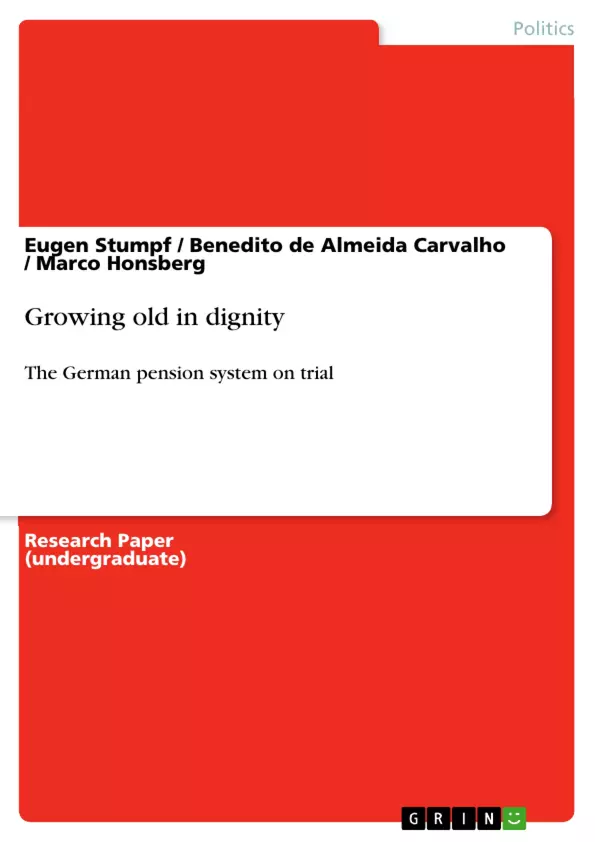This paper surveys the situation of the German pension system after a sequence of reforms
which started as a fully funded system implemented by Bismarck during the 1880s, with a
mandatory retirement age of 70 years when male life expectancy at birth was less than 45
years. Today, life expectancy for men is more than 80 years.
After a long and arduous debate in the German Bundestag, agreements on a comprehensive
pension reform resulted in the pension reform of 1957, which mainly established changes
such as the normal retirement age at 65, the retirement at the age of 60 for elderly
unemployed, the retirement for women at the age of 60 and, at last, the introduction of
dynamic benefits indexed to gross wages which had an immediate impact on the economic
wellness of current retirees.
Thereafter, the 1972 reform made the German pension system one of the most generous of
the world, as it mainly opened the public pension insurance system to all workers with
generous terms for back-payment of contributions and eased the terms and conditions for
early retirement by the implementation of the so-called ‘flexible retirement’, as discussed in
chapter 1 of this paper.
The following pension reforms discussed in this paper are the “Riester reform” of 2001 with
the following main objectives: the sustainability of contribution rates in order to secure the
long-term stability of pension levels and the spread of supplementary private pension savings,
and continuing with the efforts of the Rürup commission which culminated in the “Rürup
reform” of 2004 which the objective to stabilize contribution rates while at the same time
ensuring appropriate future pension levels.
Based on the above, it can be concluded that on the whole the sequence of pension reforms in
Germany has successfully converted what was once a so called monolithic Bismarckian public
insurance system to an efficient multi-pillar. Given this situation, as discussed in chapter 2 of
this paper, the German pension system nowadays are based in a three-pillar system, consisting
of the following elements: The first and most important pillar is universal and mandatory,
organized as a pay-as-you-go system. The second pillar is the voluntary occupational pension
system which is also universal and mandatory, but capital funded. The third pillar is also
capital funded, but organized as a voluntary private provision system.
Inhaltsverzeichnis (Table of Contents)
- Introduction
- 1. The Evolution of the German Pension System
- 1.1 Bismarck's reform of 1889
- 1.2 Reforms of 1957 & 1972
- 1.3 Riester reform of 2001
- 1.4 Rürup reform of 2004
- 2. Today's situation of the German pension system
- 2.1 The first pillar pensions and old-age pension
- 2.2 The second pillar pensions
- 2.3 The third pillar pensions
- 2.4 Demographic Development
- 3. Economic Challenges
- 3.1 Female workforce
- 3.2 Immigration
- 3.3 Recent Changes in the Pension System
- 3.4 Implications to the healthcare sector
- 4. Pension system in developed countries
- 4.1 Italy
- 4.2 Japan
- 4.3 France
- 4.4 Netherlands
- 4.5 Sweden
- 4.6 United Kingdom
- 4.7 Summary
- 5. ITM Checklist
Zielsetzung und Themenschwerpunkte (Objectives and Key Themes)
This paper analyzes the German pension system, tracing its evolution from a fully funded Bismarckian model to a multi-pillar system. It examines the impact of various reforms, focusing on their effectiveness in ensuring the long-term sustainability and adequacy of pension benefits in light of demographic changes.
- Evolution of the German pension system from a Bismarckian model to a multi-pillar system.
- Impact of key pension reforms (1957, 1972, 2001, 2004) on the system's structure and sustainability.
- Demographic trends in Germany and their economic implications for the pension system.
- Comparison of the German pension system with those of other developed countries.
- Economic challenges posed by demographic changes, including the female workforce, immigration, and healthcare.
Zusammenfassung der Kapitel (Chapter Summaries)
Introduction: Provides an overview of the German pension system's evolution and the paper's objectives.
Chapter 1: Traces the historical development of the German pension system, detailing key reforms and their impact. This includes the Bismarckian system, the reforms of 1957 and 1972, the Riester reform of 2001, and the Rürup reform of 2004.
Chapter 2: Describes the current three-pillar structure of the German pension system, including details on each pillar. It also analyzes Germany's demographic development and its projected impact on the system.
Chapter 3: Discusses the economic challenges presented by Germany's aging population, including issues related to the female workforce, immigration policies, and healthcare system implications.
Chapter 4: Offers a comparative overview of pension systems in several developed countries, including Italy, Japan, France, the Netherlands, Sweden, and the United Kingdom.
Schlüsselwörter (Keywords)
German pension system, pension reform, Bismarckian model, multi-pillar system, demographic change, aging population, economic challenges, female labor force participation, immigration, healthcare, comparative pension systems, sustainability, adequacy of pension benefits.
- Quote paper
- Dipl. Ing. Eugen Stumpf (Author), Benedito de Almeida Carvalho (Author), Marco Honsberg (Author), 2011, Growing old in dignity, Munich, GRIN Verlag, https://www.grin.com/document/181644



